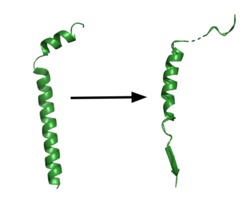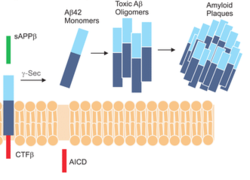Sandbox Reserved 1619
From Proteopedia
(Difference between revisions)
| Line 7: | Line 7: | ||
===Background=== | ===Background=== | ||
| - | Gamma secretase (GS) is a transmembrane [https://en.wikipedia.org/wiki/Aspartic_protease aspartatic protease] that catalyzes peptide bond hydrolysis of type I integral membrane proteins such as [https://en.wikipedia.org/wiki/Notch_signaling_pathway Notch], amyloid precursor protein (APP), and various other substrates. GS recognizes and catalyzes the cleavage of its substrate into 3 residue segments.<ref name="Bolduc" /> Products of initial APP cleavage include the 48-residue peptide Aβ48 or the 49-residue peptide Aβ49. GS then cleaves these peptides into a variety of peptide fragments separated by 3 residues; | + | Gamma secretase (GS) is a transmembrane [https://en.wikipedia.org/wiki/Aspartic_protease aspartatic protease] that catalyzes peptide bond hydrolysis of type I integral membrane proteins such as [https://en.wikipedia.org/wiki/Notch_signaling_pathway Notch], amyloid precursor protein (APP), and various other substrates. GS recognizes and catalyzes the cleavage of its substrate into 3 residue segments.<ref name="Bolduc" /> Products of initial APP cleavage include the 48-residue peptide Aβ48 or the 49-residue peptide Aβ49. GS then cleaves these peptides into a variety of peptide fragments separated by 3 residues; Aβ48 is cleaved into Aβ45, Aβ42, and Aβ38; Aβ49 is cleaved into Aβ46, Aβ43, and Aβ40. [https://en.wikipedia.org/wiki/Amyloid_beta Aβ products] are connected to neurological diseases such as [https://en.wikipedia.org/wiki/Alzheimer%27s_disease Alzheimer's disease (AD)], with varying length peptide products showing different disease symptoms. The connection between GS and AD has made a popular drug target. Various inhibitors of GS have been identified, but no inhibitors have been clinically approved for treating AD. GS is linked to important neurological functions, leading to dangerous side effects upon inhibition<ref name="Zhou">PMID:30630874</ref>. |
===Overall Structure=== | ===Overall Structure=== | ||
| Line 40: | Line 40: | ||
Inhibition of GS could be a potential AD treatment, but this would require targeting only APP cleavage over other GS substrates. APP cleavage leads to products such as Aβ42 and Aβ43,<ref name="Yang">PMID:28628788</ref> which are prone to aggregation and formation of Aβ plaques. Increased product peptide length contributes to aggregations, and many of the mutations within PS1 result in elevated ratios of Aβ42 to the shorter Aβ40.<ref name="Bai">PMID:26280335</ref> The differential binding of APP and Notch to GS provides a starting point for differentiation but will require further follow-up studies to confirm that the structural differences observed are biologically relevant. Currently, in order to combat this complex situation, differences in binding between different substrates are being utilized to create drugs that selectively inhibit APP binding with GS, and possibly create a more ideal target for AD treatment.<ref name="Zhou">PMID:30630874</ref> | Inhibition of GS could be a potential AD treatment, but this would require targeting only APP cleavage over other GS substrates. APP cleavage leads to products such as Aβ42 and Aβ43,<ref name="Yang">PMID:28628788</ref> which are prone to aggregation and formation of Aβ plaques. Increased product peptide length contributes to aggregations, and many of the mutations within PS1 result in elevated ratios of Aβ42 to the shorter Aβ40.<ref name="Bai">PMID:26280335</ref> The differential binding of APP and Notch to GS provides a starting point for differentiation but will require further follow-up studies to confirm that the structural differences observed are biologically relevant. Currently, in order to combat this complex situation, differences in binding between different substrates are being utilized to create drugs that selectively inhibit APP binding with GS, and possibly create a more ideal target for AD treatment.<ref name="Zhou">PMID:30630874</ref> | ||
| - | |||
Revision as of 13:18, 21 April 2020
Gamma Secretase
| |||||||||||
References
- ↑ 1.0 1.1 1.2 Bolduc DM, Montagna DR, Seghers MC, Wolfe MS, Selkoe DJ. The amyloid-beta forming tripeptide cleavage mechanism of gamma-secretase. Elife. 2016 Aug 31;5. doi: 10.7554/eLife.17578. PMID:27580372 doi:http://dx.doi.org/10.7554/eLife.17578
- ↑ 2.0 2.1 2.2 2.3 2.4 2.5 2.6 2.7 Zhou R, Yang G, Guo X, Zhou Q, Lei J, Shi Y. Recognition of the amyloid precursor protein by human gamma-secretase. Science. 2019 Feb 15;363(6428). pii: science.aaw0930. doi:, 10.1126/science.aaw0930. Epub 2019 Jan 10. PMID:30630874 doi:http://dx.doi.org/10.1126/science.aaw0930
- ↑ 3.0 3.1 3.2 Yang G, Zhou R, Shi Y. Cryo-EM structures of human gamma-secretase. Curr Opin Struct Biol. 2017 Oct;46:55-64. doi: 10.1016/j.sbi.2017.05.013. Epub, 2017 Jul 17. PMID:28628788 doi:http://dx.doi.org/10.1016/j.sbi.2017.05.013
- ↑ 4.0 4.1 4.2 Bai XC, Yan C, Yang G, Lu P, Ma D, Sun L, Zhou R, Scheres SH, Shi Y. An atomic structure of human gamma-secretase. Nature. 2015 Aug 17. doi: 10.1038/nature14892. PMID:26280335 doi:http://dx.doi.org/10.1038/nature14892
- ↑ Bachurin SO, Bovina EV, Ustyugov AA. Drugs in Clinical Trials for Alzheimer's Disease: The Major Trends. Med Res Rev. 2017 Sep;37(5):1186-1225. doi: 10.1002/med.21434. Epub 2017 Jan 13. PMID:28084618 doi:http://dx.doi.org/10.1002/med.21434
- ↑ Kumar D, Ganeshpurkar A, Kumar D, Modi G, Gupta SK, Singh SK. Secretase inhibitors for the treatment of Alzheimer's disease: Long road ahead. Eur J Med Chem. 2018 Mar 25;148:436-452. doi: 10.1016/j.ejmech.2018.02.035. Epub , 2018 Feb 15. PMID:29477076 doi:http://dx.doi.org/10.1016/j.ejmech.2018.02.035
Student Contributors
Layla Wisser
Daniel Mulawa


